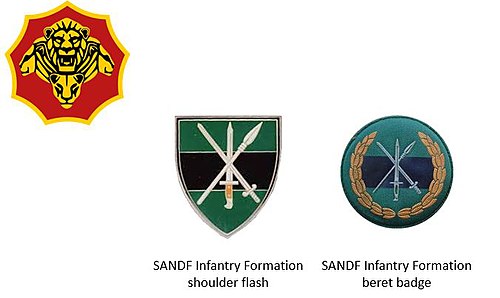History
Predecessors
While RWP was only raised in 1934, it regards itself as the successor to several small and short-lived units which were formed in the Western Cape country districts in the nineteenth century and early twentieth century. They were:
First Volunteer Movement
- Stellenbosch Volunteers –formed 1856, disbanded c. 1865
- Worcester volunteers –formed 1856, disbanded c. 1863
- Paarl Rifle Corps –formed 1856, disbanded 1859
- Malmesbury Volunteer Cavalry –formed 1856, disbanded c. 1866
- Paarl Cavalry –formed 1857, disbanded 1859
- Paarl United Volunteers –formed 1859, disbanded c. 1862
- Robertson and Montague Rifle Corps –formed 1860, disbanded c. 1864
No volunteer units in these districts between 1866 and 1878.
Second Volunteer Movement
- Worcester Volunteer Rifles –formed 1878, disbanded c. 1879
- Worcester Volunteer Rifles –formed 1885, disbanded 1901
- Paarl Volunteer Rifles –formed 1885, disbanded 1897
- Wellington Volunteer Rifles –formed 1885, disbanded 1901
- Victoria College Volunteer Rifles –formed 1888, disbanded 1899
- Robertson Volunteer Rifles –formed 1890, disbanded
- Malmesbury Volunteer Rifles –formed 1892, disbanded 1896.
- Western Rifles –an administrative grouping, which existed from 1893 to 1908, of the Worcester, Paarl, Wellington, Stellenbosch, Robertson, and Malmesbury units
- Western Light Horse –formed at Worcester 1903, disbanded 1908
- Paarl Volunteers –formed 1906, disbanded 1909.
No volunteer units in these districts between 1909 and 1913.
Citizen Force
No CF units in these districts existed between 1929 and 1934. [3] [4] [5]
Garrison
The regiment was based in the country town of Stellenbosch, 45 kilometres (28 mi) outside Cape Town, and recruited its members from the surrounding districts of the western part of the Cape Province. At that time, Citizen Force service was voluntary.
Brandy
The new Regiment lost no time in ensuring that the inner man was cared for and in 1936 the first specially bottled R.W.P brandy was produced. [6] : 60 The much honoured tradition of toasting the Regiment and dignitaries in pure, undiluted R.W.P brandy is still in use today.
With the Union Defence Force
Post war
The regiment was presented with a Regimental Colour by his Majesty King George VI during the visit of the royal family to South Africa on 31 March 1947. The wartime Prime Minister Gen Jan Smuts accepted the appointment as Colonel-In-Chief of the regiment from 17 September 1948. [10]
Remustered and renamed
In 1949, RWP itself was converted to Armour, and it was renamed Regiment Onze Jan, after 19th-century Afrikaner political leader Jan Hofmeyr, in 1951. From 1952, Citizen Force recruits were chosen by ballot rather than volunteering.
During the 1950s and 1960s the Regiment was part of the part-time component of Western Province Command.
With the SADF
When the Army was re-organised for internal security duties in 1960, Regiment Onze Jan was converted back to infantry and was renamed Regiment Boland. Regiment Boland later moved to Paarl and, after the introduction of national service conscription (in 1968), it formed a second battalion in Worcester on 1 September 1970.
The two battalions were separated in April 1974. 1 Regiment Boland resumed the original title Regiment Westelike Provinsie and moved to Cape Town, while 2 Regiment Boland remained in Worcester as Regiment Boland. The only remnant of their association is the similar cap-badges of the two regiments.
Operations
RWP served in the Angola campaign in 1976, and carried out several tours of duty in the Border War in South West Africa. It was also deployed on internal security duties in the Townships during the 1985–90 State of Emergency.
With the SANDF
Military service has been voluntary again since 1994. [6] 71 Motorised Brigade and 9 Division were dissolved in the late nineties and the regiment presently forms part of the South African Army Infantry Formation.
Name change
In August 2019, 52 Reserve Force units had their names changed to reflect the diverse military history of South Africa. [11] Regiment Westelike Provinsie was renamed General Jan Smuts Regiment, and have 3 years to design and implement new regimental insignia. [12]
Jan Smuts, the regiment's honorific, was chosen because Smuts was Colonel-in-Chief of the then Regiment Westelike Provinsie from 1948 until his death. Having served in the Boer War and in both World Wars, the latter of as part of what is now today the SANDF, he was promoted Field Marshal in 1941.
Regimental Freedoms
R.W.P has been granted the Freedom of the following Cities: [6] : 65
These honours mean that the Regiment may march on foot or mechanised with drums beating, colours flying and bayonets fixed through the streets of Cape Town or any of the Overstrand towns, namely Hermanus, Rooi Els, Pringle Bay, Betty's Bay, Kleinmond, Fisherhaven, Hawston, Onrus, Sandbaai, Stanford, Gansbaai, Uilenskraal Mond, Franskraal, Pearly Beach and Baardskeerdersbos.
This page is based on this
Wikipedia article Text is available under the
CC BY-SA 4.0 license; additional terms may apply.
Images, videos and audio are available under their respective licenses.




